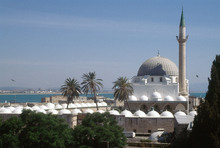| dc.description | "The large dome and slender soaring minaret of al-Jazzar's mosque dominate the cityscape of Acre. The building, designed by al-Jazzar in the classical Ottoman style, is lavishly decorated with marble and beautifully lit. The mosque was originally named Jami al-Anwar (the great mosque of lights) and was also known in the beginning as the white mosque, because of its silvery-white dome that glittered to a great distance.
The mosque was built on the site of other Muslim and Christian prayer houses on an irregular quadrangle platform. The prayer hall is located in a big courtyard flanked in three sides with vaulted arcades. From the south the courtyard borders with the Cotton Bazaar's white wall. The mosque courtyard contains a cistern, a handsome ornate sabil in front of the Mosque's entrance, a sundial that was used to inform the exact time of prayer, and the tombs of al-Jazzar and his heir Sulayman Pasha. A lock of hair said to have been taken from the Prophet Muhammad is kept in the mosque in a metal reliquary and is shown in congregation once a year in Id al-Fitr, ending the Ramadan fast.
Behind the arcades of the courtyard there are small rooms, which housed the mosque's functionaries, pilgrims, and students of its madrasa. The madrasa, al-Ahmadiyya, was named after the founder Ahmad Jazzar Pasha. In addition, the Shari court and the offices of the waqf were there, as well as one of the best libraries for Islamic literature in the area at that time. In 1900 a beautiful sabil was built by Abd al-Hamid II next to the main entrance to the courtyard."Sources:
Dichter, Bernhard. 2000. Akko-Sites from the Turkish Period. Haifa: University of Haifa, p. 108-117
Lurie, Yehoshua. 2000. Acre-The Walled City: Jews among the Arabs, Arabs among the Jews. Tel Aviv: Yaron Golan Publication, p.28-49
Petersen, Andrew. 2001. A Gazetteer of Buildings in Muslim Palestine: Part 1.Oxford: Oxford University Press p.73-76
Schur, Nathan. 1990. A History of Acre. Tel Aviv: Dvir Publishing House, p. 207-216 | en_US |

